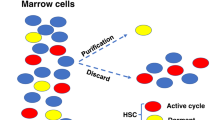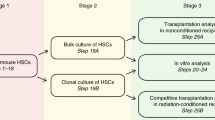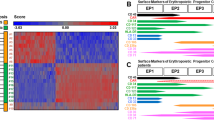Abstract
PARAMETERS such as size, density and differences in cell-cycle kinetics have been used to distinguish murine pluripotential haemopoietic stem cells (colony-forming units in the spleen, CFU-S) and committed haemopoietic progenitor cells1. Efforts to use surface membrane markers2–4 have been based on two different, mutually exclusive concepts that regard pluripotent stem cells either as ‘null-cells’ or ‘multiple-marked’ cells. The first concept suggests that the markers are sequentially expressed during differentiation and maturation of a cell. Pluripotent stem cells, being the most undifferentiated haemopoietic cells, would be expected to have no markers or at least very few. According to the ‘multiple-marked’ stem cell hypothesis, however, differentiation would be accompanied by a specific loss of markers5. CFU-S can be detected by the development of spleen colonies after transplantation of normal syngeneic bone marrow cells (BMC) into irradiated recipients6. Committed granulocyte–macrophage colony-forming cells (GM-CFC) and early or late erythroid (BFU-E or CFU-E) progenitor cells can proliferate clonally in semisolid medium in vitro if stimulated by specific growth factors, namely granulocyte–macrophage colony-stimulating factor (GM-CSF) or erythropoietin7–9. Pretreatment of normal marrow cells with a rabbit antiserum against mouse brain tissue has been reported to suppress spleen colony formation in vivo without influencing the growth of granulocyte–macrophage colonies in vitro10. We now report that antigens coded by endogenous C-type virus are expressed on pluripotent stem cells but were not detected on committed progenitor cells.
This is a preview of subscription content, access via your institution
Access options
Subscribe to this journal
Receive 51 print issues and online access
$199.00 per year
only $3.90 per issue
Buy this article
- Purchase on Springer Link
- Instant access to full article PDF
Prices may be subject to local taxes which are calculated during checkout
Similar content being viewed by others
References
Metcalf, D. Rec. Results Cancer Res. 61, 68–69 (1977).
Golub, E. S. J. exp. Med. 136, 369–374 (1972).
Thierfelder, S. Nature 269, 691–693 (1977).
Goldschneider, I. J. Immun. 118, 2040–2046 (1977).
Till, J. E. in Cells of Renewing Cell Populations (eds Cairnie, A. B., Lala, P. K. & Osmond, D. G.) 143–155 (Academic, New York, 1976).
Till, J. E. & McCulloch, E. A. Radiat. Res. 14, 213–222 (1961).
Bradley, T. R. & Metcalf, D. Aust. J. exp. Biol. med. Sci. 44, 287–300 (1966).
Pluznik, D. H. & Sachs, L. J. cell. comp. Physiol. 66, 319–324 (1965).
Iscove, N. N. & Sieber, F. Exp. Hemat. 3, 32–43 (1975).
Van den Engh, G. J. & Golub, E. S. J. exp. Med. 139, 1621–1627 (1974).
Moroni, C. & Schumann, G. Nature 269, 600–601 (1977).
Schumann, G. & Moroni, C. J. Immun. 120, 1913–1916 (1978).
Abramson, S., Miller, R. G. & Phillips, R. A. J. exp. Med. 145, 1567–1579 (1977).
Troxler, D. H., Boyars, J. K., Parks, W. P. & Scolnick, E. M. J. Virol. 22, 361–372 (1977).
Wecker, E., Schimpl, A. & Hünig, T. Nature 269, 598–600 (1977).
Guilbert, L. & Iscove, N. N. Nature 263, 594–595 (1976).
Worton, R. G., McCulloch, E. A. & Till, J. E. J. cell. Physiol. 74, 171–182 (1969).
Sheridan, J. & Metcalf, D. J. cell. Physiol. 81, 11–24 (1973).
Moroni, C. & Schumann, G. Nature 254, 60–61 (1975).
Author information
Authors and Affiliations
Rights and permissions
About this article
Cite this article
STABER, F., SCHLÄFLI, E. & MORONI, C. Expression of endogenous C-type viral antigen on normal mouse haemopoietic stem cells. Nature 275, 669–671 (1978). https://doi.org/10.1038/275669a0
Received:
Accepted:
Issue Date:
DOI: https://doi.org/10.1038/275669a0
This article is cited by
Comments
By submitting a comment you agree to abide by our Terms and Community Guidelines. If you find something abusive or that does not comply with our terms or guidelines please flag it as inappropriate.



